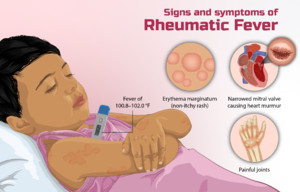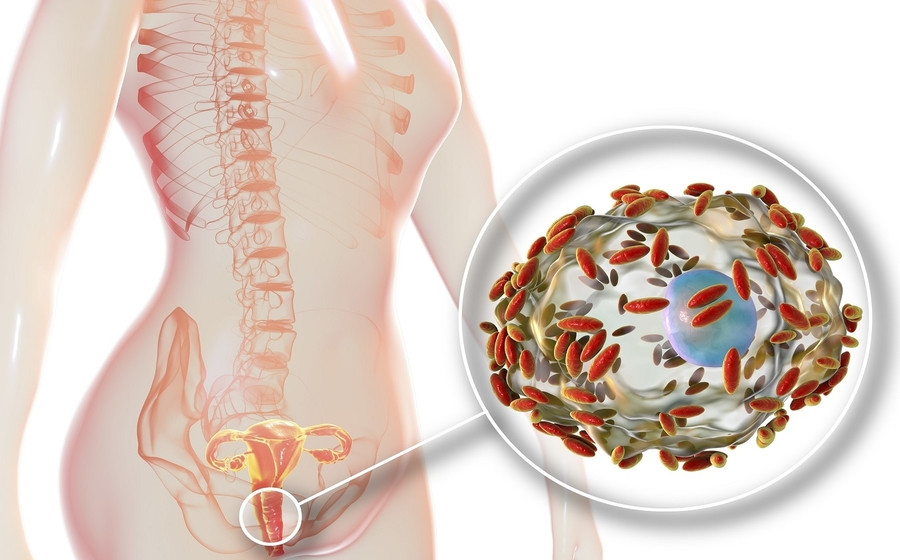Definisi
Demam reumatik adalah suatu kondisi akut yang dapat menyebabkan peradangan atau pembengkakan pada jantung, sendi, otak, dan kulit. Penyakit ini adalah komplikasi sangat langka yang bisa timbul setelah infeksi bakteri yang menyerang tenggorokan. Demam reumatik paling sering menyerang anak-anak, namun juga bisa dialami oleh remaja dan orang dewasa. Sebagian besar pasien bisa sembuh secara total, namun penyakit ini bisa kambuh kembali.
Penyebab
Demam reumatik adalah penyakit langka yang dapat muncul jika infeksi tenggorokan (strep throat) atau demam scarlet tidak ditangani dengan tepat. Penyakit ini juga bisa muncul setelah infeksi kulit akibat bakteri seperti impetigo walaupun lebih jarang terjadi. Infeksi bakteri ini awalnya disebabkan oleh bakteri Streptococcus grup A.
Sebagian orang yang mengalami infeksi bakteri umumnya tidak akan mengalami demam reumatik. Kondisi ini sebenarnya tidak disebabkan oleh bakterinya secara langsung. Sistem kekebalan tubuh akan aktif dan berusaha melawan bakteri yang memasuki tubuh, namun pada suatu waktu, sistem imun turut menyerang jaringan tubuh yang sehat.
Jadi, perlu diingat bahwa demam reumatik tidak disebabkan oleh infeksi bakteri secara langsung, namun terjadi karena respon kekebalan tubuh yang abnormal. Tidak diketahui dengan pasti penyebab sistem kekebalan tubuh berhenti bekerja dengan benar, namun hal ini menyebabkan peradangan (pembengkakan). Pada demam reumatik, terjadi peradangan terutama pada jantung, sendi, kulit dan sistem saraf pusat. Memerlukan waktu sekitar 1-5 minggu setelah infeksi bakteri untuk terjadi demam reumatik.
Jika infeksi bakteri ditangani dengan segera melalui pemberian antibiotik sesuai anjuran dokter, maka kemungkinan untuk mengalami demam reumatik menjadi kecil.
Faktor Risiko
Semua orang berisiko mengalami demam reumatik bila mereka terkena infeksi bakteri seperti radang tenggorokan atau demam scarlet. Terdapat beberapa faktor yang dapat meningkatkan risiko terkena demam reumatik yaitu:
- Usia
Demam reumatik lebih sering terjadi pada anak usia sekolah (5-15 tahun). Demam reumatik sangat jarang terjadi pada anak berusia kurang dari 3 tahun dan orang dewasa.
- Orang yang berada dalam kelompok
Infeksi bakteri seperti Streptococcus grup A, cenderung menyebar pada lokasi di mana sekelompok orang banyak berkumpul. Kondisi yang ramai dapat meningkatkan risiko terinfeksi, dan bila infeksi tidak ditangani dengan baik, respon imun tubuh yang abnormal dapat menyebabkan demam reumatik. Tempat ramai ini meliputi sekolah, tempat penitipan anak, atau fasilitas pelatihan militer.
- Faktor kesehatan lain
Orang yang pernah terkena demam reumatik sebelumnya lebih mungkin mengalami kekambuhan demam reumatik lagi di kemudian hari. Infeksi berulang bakteri Streptococcus grup A bisa meningkatkan risiko terjadinya demam reumatik.
- Faktor genetik
Ada orang-orang dengan kecenderungan genetik yang membuat seseorang lebih rentan mengalami demam reumatik, bila mereka terinfeksi Streptococcus grup A. Ada kasus-kasus demam reumatik yang ditemukan pada anggota keluarga dan saudara kembar.
- Faktor lingkungan
Risiko demam reumatik yang lebih tinggi dikaitkan dengan kondisi lingkungan yang padat, sanitasi yang baruk, kondisi sosioekonomi yang buruk, dan hal lain yang dapat menyebabkan bakteri Streptococcus mudah menyebar ke banyak orang.
Gejala
Gejala demam reumatik muncul akibat peradangan pada jantung, sendi, kulit, atau sistem saraf pusat. Demam reumatik biasanya muncul dalam beberapa minggu, sekitar 1-5 minggu setelah terkena infeksi bakteri. Gejala dapat berubah seiring perjalanan penyakit.
Gejala yang bisa timbul dari demam reumatik meliputi:
- Demam
- Kelelahan
- Nyeri pada satu sendi yang bisa menjalar ke sendi lain
- Kemerahan atau peradangan pada sendi, paling sering di sendi lutut, pergelangan kaki, siku, dan pergelangan tangan
- Pergerakan tubuh yang tersentak-sentak dan tidak terkendali, paling sering pada tangan, kaki, dan wajah
- Ruam kulit berwarna merah pucat yang tidak nyeri pada lengan atau perut
- Benjolan kecil di bawah kulit dan di dekat sendi
Selain itu, orang dengan demam reumatik dapat memiliki:
- Nyeri dada
- Sesak napas
- Denyut jantung cepat
- Adanya bising abnormal baru yang terdengar dari jantung
- Pembesaran jantung
- Penumpukan cairan di sekitar jantung
Diagnosis
Diagnosis penyakit ditegakkan melalui wawancara medis, pemeriksaan fisik dan pemeriksaan penunjang bila perlu. Dokter bisa bertanya mengenai keluhan, riwayat medis dan pengobatan yang sudah dijalani oleh pasien sebelumnya. Tanda-tanda vital dan tubuh pasien akan diperiksa secara menyeluruh untuk mencari kemungkinan penyakit yang menyebabkan kondisi pasien.
Jika dicurigai terjadi demam reumatik, dokter bisa menyarankan untuk dilakukan pemeriksaan berikut seperti:
- Pemeriksaan darah untuk mencari bila ada tanda peradangan di darah, atau keberadaan antibodi bakteri Streptococcus grup A di tubuh.
- Pemeriksaan swab atau usap tenggorok untuk mengetahui kemungkinan infeksi bakteri Streptococcus grup A.
- Elektrokardiogram (EKG) atau rekam jantung untuk mengetahui aktivitas listrik jantung.
- Ekokardiografi yaitu pemeriksaan yang menunjukkan gambaran aliran darah jantung dan katup jantung.
Tata Laksana
Tujuan pengobatan demam reumatik adalah untuk menyembuhkan infeksi bakteri Streptococcus grup A yang belum teratasi, mengatasi keluhan pasien, mengontrol peradangan yang ada dan mencegah agar penyakit tidak kambuh kembali.
Dokter bisa memberikan obat penurun panas, pereda nyeri, antiperadangan serta antibiotik. Setelah terapi antibiotik pertama untuk mengatasi infeksi bakteri Streptococcus grup A selesai, pasien bisa diberikan terapi pencegahan dengan antibiotik setiap 3-4 minggu. Terapi antibiotik ini bisa berlangsung bertahun-tahun untuk mencegah kekambuhan serta perburukan penyakit. Bila pasien mengalami keluhan pergerakan tubuh yang tersentak-sentak dan tidak terkontrol, dokter bisa memberi obat antikejang.
Pasien penyakit jantung reumatik (terjadi kerusakan katup jantung permanen karena demam reumatik) dengan gejala gagal jantung dapat membutuhkan obat jantung untuk membantu mengontrol kondisinya hingga prosedur pembedahan.
Komplikasi
Pada beberapa orang, peradangan yang disebabkan oleh demam reumatik bisa menyebabkan komplikasi jangka panjang. Salah satu komplikasi demam reumatik adalah kerusakan permanen pada jantung, dikenal dengan nama penyakit jantung reumatik. Penyakit jantung reumatik biasanya terjadi beberapa tahun atau beberapa dekade setelah penyakit awal.
Penyakit jantung reumatik bisa merusak katup jantung, pada kasus yang berat pasien bisa memerlukan operasi atau pembedahan untuk mengobati kondisinya.
Demam reumatik dapat menyebabkan kerusakan jantung seperti berikut:
- Penyempitan katup jantung, hal ini bisa mengurangi aliran darah di jantung karena darah sulit melewati katup.
- Kebocoran katup jantung, kondisi ini membuat darah tidak semuanya melalui katup dan ada sebagian yang mengalir balik ke serambi jantung.
- Kerusakan otot jantung yang bisa memengaruhi kemampuan otot jantung dalam memompa darah.
- Denyut jantung menjadi tidak teratur.
- Gagal jantung di kemudian hari.
Pencegahan
Pernah mengalami infeksi bakteri Streptococcus grup A sebelumnya tidak melindungi seseorang dari kekambuhan infeksi di kemudian hari. Anda bisa menjaga kebersihan diri dan menghindari penyebaran infeksi dengan rutin mencuci tangan. Selain itu bila Anda atau anak mengalami gangguan tenggorokan yang tidak kunjung sembuh setelah beberapa hari, sebaiknya Anda berkonsultasi ke dokter. Anda bisa mengetahui kemungkinan penyakit yang Anda derita adalah infeksi atau bukan.
Untuk mencegah demam reumatik, infeksi bakteri Streptococcus grup A harus disembuhkan dengan pengobatan antibiotik sampai tuntas. Dokter akan menyampaikan seberapa lama terapi pencegahan ini harus dilakukan.
Kapan Harus ke Dokter?
Buatlah janji dengan dokter anak Anda jika terdapat salah satu tanda atau gejala gangguan tenggorokan berikut:
- Nyeri tenggorokan yang muncul mendadak
- Nyeri saat menelan
- Demam
- Sakit kepala
- Nyeri perut
- Mual atau muntah
Mau tahu informasi seputar penyakit lainnya? Cek di sini, ya!
- dr Hanifa Rahma
Rheumatic fever: All you need to know (2022) Centers for Disease Control and Prevention. Centers for Disease Control and Prevention. Available at: https://www.cdc.gov/groupastrep/diseases-public/rheumatic-fever.html (Accessed: March 8, 2023).
Rheumatic fever (2022) Mayo Clinic. Mayo Foundation for Medical Education and Research. Available at: https://www.mayoclinic.org/diseases-conditions/rheumatic-fever/symptoms-causes/syc-20354588 (Accessed: March 8, 2023).
Rheumatic fever (2021) NHS choices. NHS. Available at: https://www.nhs.uk/conditions/rheumatic-fever/ (Accessed: March 8, 2023).












